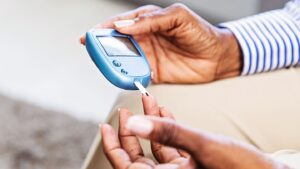Living with diabetes involves managing various symptoms and complications, and stomach pain is one of them. Whether it’s due to diabetic neuropathy, gastroparesis, or other factors, addressing stomach pain is crucial for overall well-being. In this blog, we’ll delve into the causes of stomach pain in diabetes and explore effective treatment options and strategies to alleviate discomfort.
Contents
Is Stomach Pain Common in Diabetes?

Yes, stomach pain can be common in individuals with diabetes, particularly if the condition is poorly managed or if complications such as diabetic neuropathy or gastroparesis develop. Here’s why:
- Diabetic Neuropathy: Diabetes can damage nerves throughout the body, including those that control digestion. When the nerves in the gastrointestinal tract are affected, it can lead to symptoms such as stomach pain, bloating, constipation, or diarrhea.
- Gastroparesis is a condition where the stomach takes too long to empty its contents into the small intestine. It’s a common complication of diabetes, particularly in individuals with longstanding or poorly controlled diabetes. Gastroparesis can cause symptoms such as stomach pain, nausea, vomiting, bloating, and a feeling of fullness after eating small amounts.
- Medication Side Effects: Some medications used to manage diabetes, particularly those that affect digestion or blood sugar levels, can contribute to stomach pain as a side effect. For example, certain oral diabetes medications or insulin therapy may cause gastrointestinal discomfort in some individuals.
- Dietary Factors: Poorly managed diabetes can lead to fluctuations in blood sugar levels, which may result in stomach pain. Additionally, certain foods high in fat, fiber, or sugar can exacerbate gastrointestinal symptoms in individuals with diabetes.
While stomach pain is not inevitable for all individuals with diabetes, it is relatively common, especially in those who have complications or struggle with blood sugar control. Individuals with diabetes need to work closely with their healthcare providers to manage their condition effectively and address any associated symptoms, including stomach pain.
Can We Treat Diabetes Stomach Pain?
Yes, diabetes-related stomach pain can be treated and managed effectively. Treatment approaches may vary depending on the underlying cause of the stomach pain and the individual’s overall health status.
It’s crucial for individuals experiencing diabetes-related stomach pain to work closely with their healthcare providers to develop a comprehensive treatment plan tailored to their specific needs and circumstances. By addressing the underlying causes of stomach pain and implementing appropriate treatment strategies, individuals with diabetes can effectively manage their symptoms and improve their quality of life.
Treatment Methods for Diabetes Stomach Pain
Treating stomach pain associated with diabetes involves a multifaceted approach that addresses the underlying causes of the pain while also managing symptoms effectively. Here are seven treatment methods commonly used:
Blood Sugar Management

Effective blood sugar management is crucial for individuals with diabetes to alleviate stomach pain and prevent related complications.
- When blood sugar levels are consistently high or fluctuate dramatically, it can damage nerves throughout the body, including those that control digestion.
- This damage, known as diabetic neuropathy, can lead to symptoms such as stomach pain, bloating, and indigestion.
Maintaining blood sugar levels within the target range helps prevent nerve damage and reduces the risk of gastrointestinal complications. This can be achieved through regular blood sugar monitoring, adherence to a balanced diet, and taking diabetes medications as prescribed by a healthcare provider.
Medication Adjustments
Certain diabetes medications may contribute to stomach pain as a side effect.
For example, some oral medications or insulin therapy may cause gastrointestinal discomfort in some individuals. In such cases, healthcare providers may recommend adjusting the dosage or switching to alternative medications to alleviate symptoms.
- When considering medication adjustments, healthcare providers carefully evaluate the individual’s medical history, current symptoms, and treatment goals. T
- They may prescribe alternative medications that are less likely to cause gastrointestinal side effects or adjust the dosage to minimize discomfort while still effectively managing blood sugar levels.
Individuals with diabetes need to communicate any adverse effects they experience with their medications to their healthcare provider. This allows for timely adjustments to the treatment plan to minimize side effects and optimize therapeutic outcomes.
In addition to medication adjustments, healthcare providers may also recommend complementary therapies or lifestyle modifications to help manage stomach pain and improve overall well-being. These may include dietary changes, stress management techniques, and regular exercise.
Dietary Modifications

Diet plays a significant role in managing stomach pain in diabetes. Certain foods can exacerbate gastrointestinal symptoms, while others can help alleviate discomfort and promote better digestion. Making dietary modifications is an essential component of managing stomach pain effectively.
One dietary modification that can help alleviate stomach pain in diabetes is eating smaller, more frequent meals throughout the day instead of large, heavy meals. This allows for easier digestion and prevents excessive stretching of the stomach, which can contribute to discomfort.
Choosing foods that are low in fat, fiber, and sugar can also help reduce stomach pain.
- High-fat foods can delay stomach emptying and exacerbate symptoms of gastroparesis, a common complication of diabetes characterized by delayed gastric emptying. Similarly, foods high in fiber can be difficult to digest and may worsen gastrointestinal symptoms in some individuals.
- Opting for foods with a low glycemic index can help prevent spikes in blood sugar levels, which can contribute to stomach pain. Low-glycemic index foods are digested more slowly, resulting in gradual increases in blood sugar levels and reduced risk of gastrointestinal discomfort.
In addition to making dietary modifications, individuals with diabetes need to pay attention to portion sizes and meal timing. Eating too much or too quickly can overwhelm the digestive system and lead to stomach pain. Eating meals at regular intervals and chewing food thoroughly can help promote better digestion and minimize discomfort.
Prokinetic Medications
For individuals with gastroparesis, a common complication of diabetes characterized by delayed gastric emptying, prokinetic medications may be prescribed to help improve stomach motility and alleviate symptoms such as stomach pain, nausea, and bloating.
Prokinetic medications work by enhancing the contractions of the muscles in the stomach and small intestine, which helps move food through the digestive tract more efficiently. By promoting faster gastric emptying, these medications can reduce symptoms of gastroparesis and improve overall digestive function.
There are several types of prokinetic medications available, including metoclopramide, domperidone, and erythromycin. These medications may be used alone or in combination with other treatments to manage symptoms and improve the quality of life for individuals with gastroparesis.
Before prescribing prokinetic medications, healthcare providers carefully assess the individual’s medical history, current symptoms, and treatment goals. They may also perform diagnostic tests such as gastric emptying studies to confirm the diagnosis of gastroparesis and determine the most appropriate treatment approach.
Pain Management
Managing stomach pain in diabetes often involves addressing the underlying causes of the pain and providing symptomatic relief. Pain management strategies may include both pharmacological and non-pharmacological interventions to alleviate discomfort and improve overall well-being.
One common approach to pain management in diabetes is the use of over-the-counter pain relievers such as acetaminophen or ibuprofen. These medications can help reduce inflammation and alleviate mild to moderate stomach pain. However, it’s important to use pain relievers cautiously and according to the manufacturer’s recommendations, as excessive or prolonged use can lead to adverse effects.
In addition to over-the-counter pain relievers, healthcare providers may prescribe medications specifically targeted at managing stomach pain associated with diabetes. For example, medications that help regulate gastric motility, such as prokinetics, can help alleviate symptoms of gastroparesis and reduce stomach pain.
Non-pharmacological interventions can also play a valuable role in pain management for individuals with diabetes. Techniques such as relaxation exercises, deep breathing, and guided imagery can help reduce stress and promote relaxation, which may in turn alleviate stomach pain.
Physical therapy and massage therapy may also be beneficial for individuals experiencing stomach pain related to diabetes. These modalities can help improve circulation, reduce muscle tension, and alleviate discomfort in the abdominal area.
In some cases, complementary therapies such as acupuncture or chiropractic care may be recommended to help manage stomach pain and improve overall well-being. These alternative treatments can complement traditional medical approaches and provide additional relief for individuals with diabetes.
Lifestyle Modifications

Adopting a healthy lifestyle is essential for managing stomach pain in diabetes and promoting overall well-being. Lifestyle modifications can help alleviate symptoms, improve digestive health, and reduce the risk of complications associated with diabetes.
Regular exercise is an integral part of a healthy lifestyle and can play a significant role in managing stomach pain in diabetes. Physical activity helps stimulate digestion, improve circulation, and reduce stress, all of which can help alleviate gastrointestinal symptoms. Aim for at least 30 minutes of moderate-intensity exercise most days of the week, such as brisk walking, cycling, or swimming.
Stress management techniques such as meditation, deep breathing exercises, and yoga can help reduce stress levels and alleviate stomach pain in diabetes. Chronic stress can exacerbate gastrointestinal symptoms and contribute to digestive problems, so finding effective ways to manage stress is essential for overall well-being.
Adequate hydration is crucial for maintaining digestive health and preventing stomach pain in diabetes. Drinking plenty of water throughout the day helps keep the digestive system hydrated and facilitates the movement of food through the gastrointestinal tract. Aim to drink at least 8-10 cups of water per day, or more if you’re physically active or live in a hot climate.
Avoiding smoking and excessive alcohol consumption is important for managing stomach pain in diabetes. Both smoking and alcohol can irritate the digestive tract and exacerbate gastrointestinal symptoms. Quitting smoking and limiting alcohol intake can help reduce stomach pain and improve overall digestive health.
Finally, getting an adequate amount of sleep is important for managing stomach pain in diabetes. Poor sleep quality can exacerbate gastrointestinal symptoms and contribute to digestive problems. Aim for 7-9 hours of quality sleep per night to help alleviate stomach pain and promote overall well-being.
Medical Interventions
In some cases, more advanced medical interventions may be necessary to manage severe or refractory stomach pain associated with diabetes. These interventions are for individuals who do not respond to conservative treatments or who have complications that require additional medical management.
- One such intervention is gastric electrical stimulation (GES), which involves implanting a device in the abdomen that delivers electrical impulses to the stomach. GES can help regulate gastric motility and alleviate symptoms of gastroparesis, such as stomach pain, nausea, and vomiting. Professionals often recommend it for individuals with severe gastroparesis who have not responded to other treatments.
- Another medical intervention for managing stomach pain in diabetes is botulinum toxin injections. This procedure involves injecting botulinum toxin into the muscles of the stomach to help relax them and improve gastric emptying. Botulinum toxin injections help the individuals with severe gastroparesis who have not responded to other treatments and are not candidates for surgery.
- Surgical interventions may also be considered for managing stomach pain in diabetes, particularly in cases of severe gastroparesis or other gastrointestinal complications. Surgical options may include gastric bypass surgery or gastric pacemaker implantation, depending on the individual’s specific needs and circumstances.
Before undergoing any medical intervention for stomach pain in diabetes, it’s important to discuss the risks and benefits with your healthcare provider. They can help determine the most appropriate treatment approach based on your medical history, current symptoms, and treatment goals.
Conclusion
Stomach pain is a common symptom experienced by individuals with diabetes, often due to diabetic neuropathy, gastroparesis, medication side effects, or dietary factors. Effective management of diabetes-related stomach pain involves maintaining blood sugar levels within the target range, making dietary modifications, adjusting medications as needed, and incorporating lifestyle changes.
Individuals with diabetes need to work closely with their healthcare providers to develop a comprehensive treatment plan tailored to their specific needs and circumstances. By actively managing stomach pain and addressing its underlying causes, individuals with diabetes can improve their quality of life and overall well-being.
Do you want to get rid of diabetes? Join our online diabetes treatment program and reverse Diabetes naturally through lifestyle changes such as a Personalized Diet plan, Exercise, Yoga, dieticians, and health coaches.

